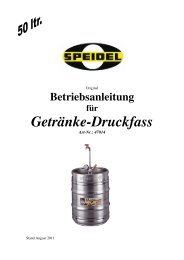Operating and brewing instructions 50l april 2008 - Speidel Tank
Operating and brewing instructions 50l april 2008 - Speidel Tank
Operating and brewing instructions 50l april 2008 - Speidel Tank
Create successful ePaper yourself
Turn your PDF publications into a flip-book with our unique Google optimized e-Paper software.
<strong>Speidel</strong>’s Master Brewer<br />
Cancel / back:<br />
↓+↑ simultaneously returns to the initial display of the Master<br />
Brewer.<br />
In all operating modes (automatic, programming mode <strong>and</strong><br />
manual operation), pressing the buttons ↓+↑ returns the user to<br />
the initial position.<br />
3.3 Advice about the recirculating pump<br />
The recirculating pump can be switched on <strong>and</strong> off via the switch that is located on the<br />
electrical box. It is important that the pump is ventilated after filling up with <strong>brewing</strong><br />
water, so that it has the full output. This is done by switching the pump on <strong>and</strong> off<br />
several times when filled up with water <strong>and</strong> a mounting position of the pump of 45°<br />
(until no bubbles of air escape any longer <strong>and</strong> hardly any noise can be heard from the<br />
pump).<br />
3.4 Advice about the container’s lid<br />
The lid assists the temperature being reached more quickly during heating. The<br />
ventilating slots avoid pressure building up in the boiler <strong>and</strong> they allow the air to<br />
circulate slightly. Water condenses on the lid’s underside at higher temperatures. Care<br />
must be taken when lifting the lid, that the lid’s rim is held over the boiler’s opening,<br />
so that the condensation which runs off (when holding the lid obliquely), runs back<br />
into the boiler <strong>and</strong> does not run down outside it.<br />
3.5 Advice about hygiene<br />
Hygiene is of paramount importance when <strong>brewing</strong> beer. The beer or the wort is<br />
exposed to the danger of infection in the cold area especially (when cooling, bottling<br />
[decanting] <strong>and</strong> fermenting), which can spoil the beer <strong>and</strong> ruin the whole work.<br />
Therefore pay special attention to absolutely clean containers, (fermenting cask <strong>and</strong><br />
bottles) <strong>and</strong> working materials (spoons, stop cocks <strong>and</strong> seals). Sulphurous acid is<br />
particularly suitable for disinfecting these containers <strong>and</strong> objects: it is obtainable from<br />
specialized vintners <strong>and</strong> hobby-<strong>brewing</strong> shops. This powder is mixed with water <strong>and</strong><br />
thinned: it is suitable for pouring into the fermenting bung, for disinfecting the<br />
fermenting container, other utensils <strong>and</strong> even the h<strong>and</strong>s. It is typically recommended to<br />
use a bucket of sulphurous acid, in which the h<strong>and</strong>s <strong>and</strong> utensils are disinfected during<br />
the <strong>brewing</strong> <strong>and</strong> before the bottling. The fermenting cask containing 3 to 5 litres of<br />
sulphurous acid is sealed <strong>and</strong> allowed to st<strong>and</strong> for several hours. Shake the cask<br />
several times in the meantime, then empty it <strong>and</strong> allow droplets to drain out before<br />
use. It is unnecessary to rinse it out with water. A few droplets or residue from the<br />
sulphurous acid in the beer are not a cause for concern as a result. Storage casks <strong>and</strong><br />
maturing casks are disinfected just like the fermenting containers. The bottles are<br />
disinfected by heating them up in an oven, if the beer is decanted into bottles with<br />
stirrup stoppers for maturation <strong>and</strong> storage after the fermentation. The rubber seals are<br />
removed from the stirrup stoppers <strong>and</strong> then boiled in hot water or immersed in<br />
sulphurous acid. The bottles are heated up in the oven to a temperature of approx.<br />
130°C. The bottles are allowed to cool down to room temperature after that by means<br />
of switching off the oven <strong>and</strong> they are then sealed with the disinfected seals. It is thus<br />
guaranteed that the fermented beer will be decanted into absolutely sterile containers.<br />
This work should be done several days before the fermenting, so that the decanting<br />
process can take place quickly <strong>and</strong> not at a frantic pace.<br />
Page 5 of 26
















